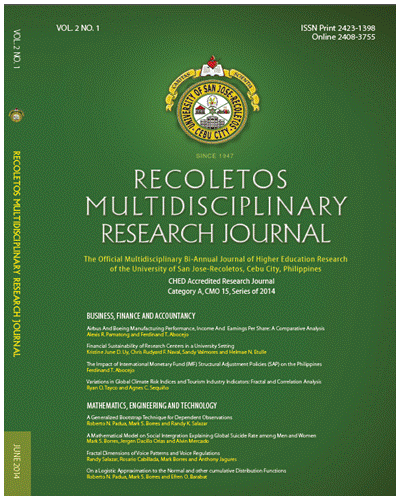A Mathematical Model on Social Integration Explaining Global Suicide Rate Among Men and Women
DOI:
https://doi.org/10.32871/rmrj1402.01.06Keywords:
suicide, mathematical modeling, social factors, global suicide rate, Human Development ReportAbstract
This paper aims to present a mathematical model for explaining global suicide rate among men and women across the world since 2007. Analysis of this nature grants a valuable input to comprehensively associate suicide incidence in men and women to its socially perceivable integrated factors. This paper is designed from a descriptive approach, data mining technique, utilizing available data taken from the Human Development Report 2013 of the United Nations where social integration indicators were specified. Results indicated a huge variation between the incidences of men and women suicide rates and from among the specified indicators; more pronounced in men than women. The variations can be explained by the significant societal-integrated factors affecting men including Well-being Index (p-value 0.03), Societal Index(P=0.00), and Safety Index (P=0.05) while only Societal Index (P=0.00) has contributed significantly to the occurrence of the phenomenon in women. This gender-based and social integration based analysis can significantly contribute to understanding of suicide and designing more effective suicide preventions and interventions for both men and women in the society.
References
Brody, E. An Emotional Hair Trigger, Often Misread, New York Times: Health
Centers for Disease Control and Prevention, National Center for Injury Prevention and Control. Webbased Injury Statistics Query and Reporting System (WISQARS) [online]. (2010). [cited 2012 Oct 19] Available from www.cdc.gov/injury/wisqars/index.html
Centers for Disease Control and Prevention. Youth risk behavior surveillance—United States, 2011. MMWR, Surveillance Summaries 2012;61(no. SS-4). Available from www.cdc.gov/mmwr/pdf/ss/
ss6104.pdf
Cheng, A. T. A. (1995). Mental illness and suicide: A casecontrol
study in east Taiwan. Archives of General Psychiatry 52, 594-603.
Crosby AE, Han B, Ortega LAG, Parks SE, Gfoerer J. Suicidal thoughts and behaviors among adults aged ≥18 years-United States, 2008-2009. MMWR Surveillance Summaries 2011;60(no. SS-13).
Available from www.cdc.gov/mmwr/preview/mmwrhtml/ss6013a1.htm?s_cid=ss6013a1_e.
Durkheim, E (1897). Le suicide. Alcan. Paris.
Emanuel, E, Fairclough, D, and Emanuel, L (2000). Attitudes and desires related to euthanasia and physician-assisted suicide among terminally ill
patients and their caregivers. JAMA 15, 2460-2468.
Goldsmith SK, Pellmar TC, Kleinman AM, Bunney WE, editors. Reducing suicide: a national imperative. Washington, DC: National Academy Press; 2002.
Groenewoud, J, Van Der Maas, P, Van Der Wal, G, Hengeveld, M W, Tholen, A, Schudel, W, and Van Der Heide, A (1997). Physician-assisted death in psychiatric practice in the Netherlands. New England Journal
of Medicine 336, 1795-1801.
Harsch DL, Logan J, McDaniel D, Parks S, Patel N. Surveillance for violent deaths—National Violent Death Reporting System, 16 States, 2013. MMWR Surveillance Summary 2012; 61:1-43. Available at: http://
www.cdc.gov/mmwr/preview/mmwrhtml/ss6106a1.htm?s_cid=ss6106a1_e#tab6.
Rich, C L, Young, D, and Fowler, R C (1986). San Diego suicide study: I. Young vs old subjects. Archives of General Psychiatry 43, 577-582.
Robins, E, Murphy, G E, Wilkinson, R H, Gassner, S, and Kayes, J (1959). Some clinical considerations in the prevention of suicide based on a study of 134 successful suicides. American Journal of Public
Health 49, 888-899.
Salmela. Anu (2009). Lethal Emotions: Shaken Emotions and Female Suicides in Late 19th Century Finland
Downloads
Published
How to Cite
Issue
Section
License
Copyright of the Journal belongs to the University of San Jose-Recoletos


